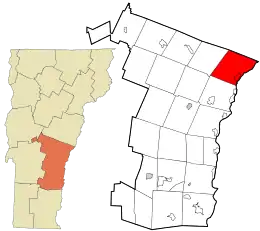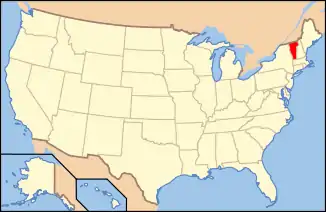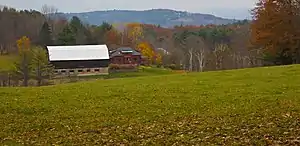Norwich, Vermont
Norwich is a town in Windsor County, Vermont, United States. The population was 3,612 at the 2020 census.[3] Home to some of the state of Vermont's wealthiest residents, the municipality is a commuter town for nearby Hanover, New Hampshire across the Connecticut River. The town is part of the Dresden School District, the first interstate school district in the United States, signed into law by President John F. Kennedy. The town contains the Norwich Mid-Century Modern Historic District.[4]
Norwich | |
|---|---|
 Location in Windsor County and the state of Vermont. | |
 Location of Vermont within the US | |
| Coordinates: 43°43′49″N 72°18′11″W | |
| Country | United States |
| State | Vermont |
| County | Windsor |
| Chartered | 1761 |
| Area | |
| • Total | 44.7 sq mi (115.7 km2) |
| • Land | 44.4 sq mi (115.1 km2) |
| • Water | 0.2 sq mi (0.6 km2) |
| Elevation | 531 ft (274 m) |
| Population (2020) | |
| • Total | 3,612 |
| • Density | 81/sq mi (31/km2) |
| Time zone | UTC−5 (EST) |
| • Summer (DST) | UTC−4 (EDT) |
| ZIP code | 05055 |
| Area code | 802 |
| FIPS code | 50-52900[1] |
| GNIS feature ID | 1462166[2] |
| Website | www |
History

The boundaries of Norwich were established on July 4, 1761, when Governor Benning Wentworth of New Hampshire defined the boundaries of townships in Vermont.[5] The first settlers reached the area in 1763 and began to clear the wilderness and erect the first hand-hewn log buildings, wintering over for the first time in 1765.[6] Early settlements occurred along the Ompompanoosuc River. Later, the current village site became settled. The first town meeting occurred in April 1768. The first Congregational church was founded in 1770 and a structure built in 1778. The population grew from 206 in 1771 to 1,158 in 1791 and 2,316 in 1830.[7]
The town was named after Norwich, Connecticut, the state from which the first settlers originated.[8] In the original charter, the name was spelled "Norwhich", but the additional 'h' was dropped shortly after the town was chartered.[9] Originally pronounced "Norritch" (similar to the English pronunciation of the city of Norwich, England), the town name has in more recent times become more commonly pronounced "Nor-wich".
Alden Partridge and the founding of Norwich University
In 1819 native son, Alden Partridge, a former Superintendent of the United States Military Academy at West Point, New York, founded the private "American Literary, Scientific and Military Academy" in Norwich.[10] He hoped to establish a new "American system" for training cadets that included both humanities and science topics in the curriculum, in addition to military science. In his six years of Norwich residency, Partridge achieved an academy population of nearly 500 "cadets". He moved that school back to Middletown, Connecticut, in 1825, but returned in 1835 with a charter from the U.S. Congress to found another military academy, which remained in Norwich until 1866, when it burned to the ground. The school then relocated to Northfield, Vermont, where it exists today as Norwich University. [7]
Geography

Norwich lies on the western bank of the Connecticut River, which forms Vermont's boundary with New Hampshire, opposite its companion town, Hanover, New Hampshire. The Ledyard Bridge connects the two towns. The Vermont towns bordering Norwich are Thetford to the north, Sharon to the west, and Hartford to the south.
According to the United States Census Bureau, the town has a total area of 44.7 square miles (115.7 km2), of which 44.4 square miles (115.1 km2) is land and 0.23 square miles (0.6 km2), or 0.05%, is water. The Ompompanoosuc River flows into the Connecticut River in the northeastern part of the town.[11]
The landscape is hilly and wooded. The elevation of the town center is 531 feet (162 m). The hills in the town include the 1,700-foot (520 m) Griggs Mountain in the southwestern section and the 1,853-foot (565 m) Gile Mountain in the northwestern section.
Demographics
| Census | Pop. | Note | %± |
|---|---|---|---|
| 1790 | 1,158 | — | |
| 1800 | 1,486 | 28.3% | |
| 1810 | 1,812 | 21.9% | |
| 1820 | 1,985 | 9.5% | |
| 1830 | 2,316 | 16.7% | |
| 1840 | 2,218 | −4.2% | |
| 1850 | 1,978 | −10.8% | |
| 1860 | 1,759 | −11.1% | |
| 1870 | 1,639 | −6.8% | |
| 1880 | 1,471 | −10.3% | |
| 1890 | 1,304 | −11.4% | |
| 1900 | 1,303 | −0.1% | |
| 1910 | 1,252 | −3.9% | |
| 1920 | 1,092 | −12.8% | |
| 1930 | 1,371 | 25.5% | |
| 1940 | 1,418 | 3.4% | |
| 1950 | 1,532 | 8.0% | |
| 1960 | 1,790 | 16.8% | |
| 1970 | 1,966 | 9.8% | |
| 1980 | 2,398 | 22.0% | |
| 1990 | 3,093 | 29.0% | |
| 2000 | 3,544 | 14.6% | |
| 2010 | 3,414 | −3.7% | |
| 2020 | 3,612 | 5.8% | |
| U.S. Decennial Census[12] | |||
As of the census[1] of 2000, there were 3,544 people, 1,367 households, and 944 families residing in the town. The population density was 79.3 people per square mile (30.6 people/km2). There were 1,505 housing units at an average density of 33.7 per square mile (13.0/km2). The racial makeup of the town was 95.97% White, 0.48% African American, 0.20% Native American, 1.61% Asian, 0.03% Pacific Islander, 0.62% from other races, and 1.10% from two or more races. Hispanic or Latino people of any race were 0.79% of the population.
There were 1,367 households, out of which 41.1% had children under the age of 18 living with them, 58.1% were married couples living together, 8.7% had a female householder with no husband present, and 30.9% were non-families. 24.2% of all households were made up of individuals, and 8.6% had someone living alone who was 65 years of age or older. The average household size was 2.59 and the average family size was 3.10.
In the town, the population was spread out, with 29.3% under the age of 18, 4.9% from 18 to 24, 23.6% from 25 to 44, 31.3% from 45 to 64, and 11.0% who were 65 years of age or older. The median age was 41 years. For every 100 females, there were 95.7 males. For every 100 females age 18 and over, there were 90.1 males.
The median income for a household in the town was $66,000, and the median income for a family was $78,178. Males had a median income of $49,350 versus $33,871 for females. The per capita income for the town was $35,285. About 1.5% of families and 3.8% of the population were below the poverty line, including 1.1% of those under age 18 and 6.2% of those age 65 or over.

Commerce and culture
The town commercial center features a traditional, but actively used, general store.[13] Adjacent to the general store is a restored historic inn with a restaurant and brew pub.[14] The Montshire Museum of Science[15] and King Arthur Baking Company are located in Norwich.[16]
Education
Norwich maintains one of the few interstate public school systems, the Dresden School District, commissioned by President John F. Kennedy, which is shared by the towns of Norwich and Hanover, New Hampshire.[17] Students attend Marion Cross School in Norwich for kindergarten through sixth grade, Richmond Middle School in Hanover for grades seven and eight, and Hanover High School in Hanover for grades nine through twelve.[18][19]
Transportation
Major transportation routes, which run parallel through the Connecticut River valley, include Interstate 91 (Exit 13 serves the town), U.S. Route 5 and the former Boston and Maine Railroad right of way, now owned by the State of Vermont.[20] The Appalachian Trail passes south to east through the town from Hartford to Hanover, New Hampshire.[21]
Notable people
- Elizabeth Emerson Atwater, 19th-century botanist
- William Barron, United States Marshal for the District of Vermont[22][23]
- Charles L. Bartlett, Mayor of Marlborough, Massachusetts[24]
- Paul Brigham, second governor of Vermont[25]
- Heinrich Brüning, German chancellor of the Weimar Republic[26]
- Daniel Azro Ashley Buck, US congressman[27]
- Nicholas A. Christakis, sociologist, professor and physician[28]
- Zerah Colburn, child prodigy "mental calculator"[29]
- George A. Converse, Spanish–American War era navy admiral[24]
- Pamela Kyle Crossley, historian[30]
- Jonathan Finer, current Deputy National Security Advisor in Biden administration; prior Chief of Staff and Director of Policy Planning for former Secretary John Kerry at the U.S. Department of State[31]
- Joseph D. Hatch, Vermont state legislator and mayor of Burlington, Vermont[32]
- Jim Holland, Olympic ski jumper (1992 & 1994)[33]
- Joe Holland, Olympic Nordic combined skier (1988 & 1992)[34]
- Mike Holland, Olympic ski jumper (1984 & 1988)[34]
- Norris Hoyt, politician and lawyer[35]
- Hannah Kearney, Olympic medalist mogul skier (2010 gold, 2014 bronze)[36]
- Bob Keeshan, television's "Captain Kangaroo"[37]
- Laurence G. Leavitt, headmaster of Vermont Academy, Saxtons River[38]
- Tony Lupien, first baseman with the Red Sox, Phillies and White Sox[39]
- David Macaulay, author and illustrator[40]
- Felix McGrath, Olympic alpine skier[41][42]
- Freya von Moltke, author and lecturer on German resistance to Nazism[43]
- Robby Mook, presidential campaign manager for Hillary Clinton[44]
- George Sylvester Morris, educator and philosophical writer[45]
- Alden Partridge, founder of Norwich University[10]
- Lewis Samuel Partridge, nephew of Alden Partridge, U.S. Marshal for Vermont, and Adjutant General of the Vermont Militia[46]
- Kevin Pearce, snowboarder[47]
- Simon Pearce, glassblower; designer; restaurateur[48]
- Thomas E. G. Ransom, general in the American Civil War[24]
- Eugen Rosenstock-Huessy, historian and social philosopher[49]
- Paul Sample, artist[50]
- Walter H. Stockmayer, chemist and Dartmouth College professor[51]
- Andrew Wheating, Olympic 800-meter runner (2008)[52]
- Edward Bancroft Williston, Medal of Honor recipient[24]
- George Wright, general in the American Civil War[24]
References
- "U.S. Census website". United States Census Bureau. Retrieved January 31, 2008.
- "US Board on Geographic Names". United States Geological Survey. October 25, 2007. Retrieved January 31, 2008.
- "Census - Geography Profile: Norwich town, Windsor County, Vermont". United States Census Bureau. Retrieved January 3, 2022.
- National Park Service (January 3, 1991). "National Register of Historic Places Registration Form: Norwich Village Historic District". npgallery.nps.gov. Retrieved June 20, 2020.
- Slafter, Edmund Farwell (1869). The Charter of Norwich, Vermont: And Names of the Original Proprietors : with Brief Historical Notes. Boston: David Clapp & Son. pp. 3.
Wentworth town boundaries Norwich VT.
- "About Norwich". norwich.vt.us. Town of Norwich Vermont. June 15, 2012. Retrieved July 3, 2014.
- Goddard, M.E.; Partridge, Henry V. (1905), A History of Norwich, Vermont, Hanover, New Hampshire: Dartmouth Press
- "Profile for Norwich, Vermont, VT". ePodunk. Retrieved July 2, 2014.
- "Norwich". VirtualVermont.com. July 15, 2009.
- Tucker, Spencer and Arnold, James R. (2012). The Encyclopedia of the War of 1812: A Political, Social, and Military History, Volume 1. ABC-CLIO. p. 560. ISBN 9781851099566. Retrieved July 3, 2014.
{{cite book}}: CS1 maint: multiple names: authors list (link) - DeLorme (1996). Vermont Atlas & Gazetteer. Yarmouth, Maine: DeLorme. ISBN 0-89933-016-9
- "U.S. Decennial Census". United States Census Bureau. Retrieved May 16, 2015.
- "Vermont Association of Independent Country Stores description of Dan and Whit's General Store". vaics.org.
- Harris, Patricia; Lyon, David (October 12, 2008), "Vermont inn brews Yankee spirit, English pints", Boston Globe, retrieved January 29, 2010
- "Montshire Museum of Science". Montshire Museum of Science. Retrieved July 3, 2014.
- "King Arthur Flour". King Arthur Flour. Retrieved July 3, 2014.
- "One of John F. Kennedy's Last Acts: President Signed Dresden District Law Shortly Before Assassination". Valley News. Retrieved July 3, 2014.
- "Marion Cross School". Marion Cross School. Retrieved July 3, 2014.
- "Hanover High School". Hanover High School. Retrieved July 3, 2014.
- "Welcome to VTrans - Agency of Transportation". railroads.vermont.gov. Archived from the original on February 4, 2010. Retrieved January 31, 2010.
- Appalachian Trail Conservancy. "Find a Hike". Retrieved July 4, 2011.
- "New Hampshire Births and Christenings Index, 1714-1904, Entry for William Barron". Ancestry.com. Lehi, UT: Ancestry.com, LLC. Retrieved February 2, 2020.
- McKeen, Silas (1875). A History of Bradford, Vermont. Montpelier, VT: J. D. Clark & Son. pp. 191-193 – via Internet Archive.
- "Norwich, Vermont". City-Data.com. Retrieved July 3, 2014.
- "Paul Brigham Papers". The University of Vermont Libraries. Retrieved July 3, 2014.
- "Heinrich Brüning". Encyclopædia Britannica. Retrieved July 3, 2014.
- "BUCK, Daniel Azro Ashley, (1789 - 1841)". Biographical Directory of the United States Congress. Retrieved July 3, 2014.
- Earle, Sarah (May 30, 2019). "Norwich author examines the traits common to good societies". Valley News. Retrieved May 31, 2019.
- W. W. Rouse Ball (1960) Calculating Prodigies, in Mathematical Recreations and Essays, Macmillan, New York, chapter 13.
- Crossley, Pamela Kyle (2010). The Wobbling Pivot, China since 1800: An Interpretive History. John Wiley & Sons. p. 1. ISBN 9781444319965. Retrieved July 3, 2014.
- Lilienthal, Mark (March 14, 2016). "Profile: Norwich Native Jon Finer Is 'Never Off the Clock' at the State Department". The Valley News. Retrieved April 1, 2019.
- Carleton, Hiram (1903). Genealogical and Family History of the State of Vermont. Vol. I. New York, NY: Lewis Publishing Company. pp. 305–306. ISBN 9780806347943 – via Google Books.
- "SKI JUMPING TITLE TO HOLLAND". Deseret News. Retrieved July 3, 2014.
- "Meet the Athletes: Ski Jumpers in the Eastern USA". EASTERN SKI JUMPING & NORDIC COMBINED FOUNDATION, INC. Archived from the original on July 14, 2014. Retrieved July 3, 2014.
- "Norris Hoyt". Rutland Herald. Retrieved July 3, 2014.
- "Hannah Kearney". United States Olympic Committee. Archived from the original on September 27, 2013. Retrieved July 3, 2014.
- Flocker, Michael (2002). Vermont: The Green Mountain State. Gareth Stevens. p. 41. ISBN 9780836851465. Retrieved July 3, 2014.
- "A Remembrance". Dartmouth. Retrieved July 3, 2014.
- "Tony Lupien". Baseball-Reference.com. Retrieved July 3, 2014.
- "David Macaulay". John D. and Catherine T. MacArthur Foundation. Retrieved July 3, 2014.
- Lochner, Bob (February 7, 1987). "U.S. Skier Criticizes Coaches : McGrath Cites Tension and Rebellion on Team". Los Angeles Times.
-
editors (2016). "Felix McGrath". SR/Olympic Sports. Sports Reference LLC. Archived from the original on April 18, 2020. Retrieved June 11, 2017.
{{cite web}}:|last=has generic name (help) - "Legacy of a Witness to the Struggles of Good and Evil". Valley News. Retrieved July 3, 2014.
- Heintz, Paul (September 18, 2013). "Take Back Virginia? Old Dominion Dems Are Counting on Vermont-Born Robby Mook". Seven Days. Retrieved October 4, 2013.
- "Morris, George Sylvester". Vermont in the Civil War. Retrieved July 3, 2014.
- "Lewis Samuel Partridge". Ancestry.com. Retrieved July 4, 2014.
- "Home at last". ESPN.com. June 16, 2010. Retrieved July 9, 2014.
- Branch, John (May 3, 2010). "No Place Like This for Soothing Care". The New York Times. Retrieved February 26, 2011.
- "Eugen Rosenstock-Huessy (1888-1973)". Argo Books. Archived from the original on September 30, 2007. Retrieved July 9, 2014.
- "Paul Sample, American, 1896-1974". Hood Museum of Art. Retrieved July 9, 2014.
- "Dr. Walter H. Stockmayer (1914-2004)". Dartmouth College. Retrieved July 9, 2014.
- "Andy Wheating '06 Wins Junior Olympics in Cross Country". Kimball Union Academy. Retrieved July 9, 2014.



